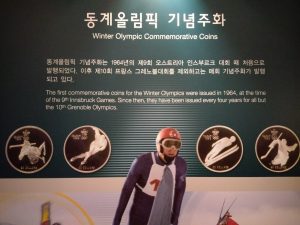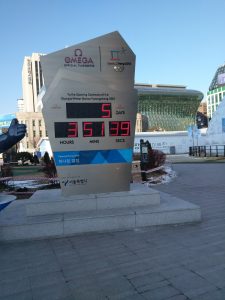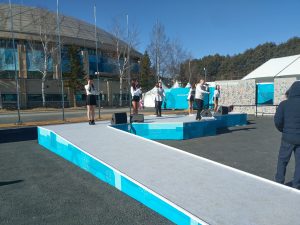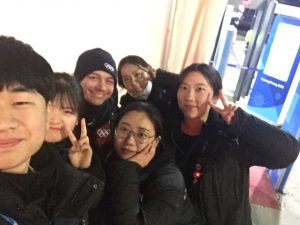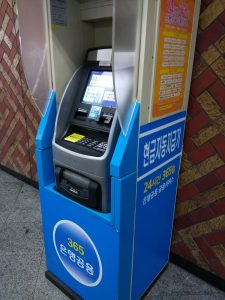As the closing ceremony closed out the Olympics in PyeonChang and the Paralympics begin to set up shop, the big question on many minds is what's next. South Korea wanted to make PyeongChang a winter destination for the Asian world, but most are not convinced. With the lack of accessibility, a under populated workforce to serve the masses South Korea is hoping for, and budget constraints on upkeep, it is likely that with other large winter venues in China and Japan, that PyeongChang becomes the next Aspen, CO.
Author: Adam T
When in Rome (or Canada House)
Only the Olympics can bring countries and people to accept and invite one another like we are all actually humans, and the country houses were no exception. Everyone regularly cheers on other countries while visiting those houses, and sometimes even wears the colors. The experience of seeing so many people happy to associate with other nationalities was very enlightening and enjoyable...and I even got to wear a Canadian flag!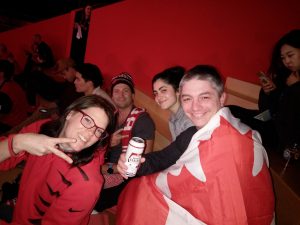
Why the Majority of Volunteers Were Women
As most who traveled to PyeongChang probably noticed, the vast majority of Korean volunteers were women do I was very curious as to why. Well talking to the ones I had the pleasure of meeting, they were volunteering to to help build their resume and experience. While interesting, what was more peculiar is why not as many men were doing the same. Well, as it turns out, 74% of working age men are employed while only 52% of women, meaning that there are a much larger population of women in Korea that would not have to worry about missing work to participate, or hope that the experience helps with prospects.
Data obtained by KOSIS Statistical Data.
http://kosis.kr/eng/statisticsList/statisticsList_01List.jsp
Better That Expected
When I realized I was working g the gold medal event for figure skating, I was kind of neutral on the event. My first choice was hockey and had no interest in figure skating. A few times I even considered trading events to give someone who would appreciate it the chance to go. Well the event came and I had not traded, so it was my turn to see what this was all about and boy was I glad I did. The ice dancing in particular reminded me much more of a play on skates or interpretative dance than just tossing someone into the air. The creativity associated with the sets were outstanding and I will definitely be looking forward to seeing those events in the future.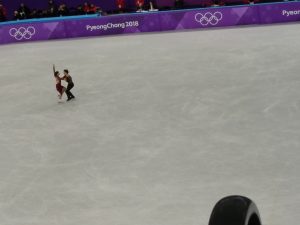
Olympics in Seoul
Walking around Seoul it was almost like the Olympics were not even going on two hours away. There were few official stores, information desks, and a countdown. In the Bank of Korea, however, was a hint of legacy being built; the Olympic commemorative coin set. They are not available yet, or on display. It also was not clear what country creates each set. I assume the host country, but all of the previous sets looked so similar in size and design I wasn't sure. So if you have a couple hours for Seoul on the way back, be sure to check out the Olympic clock and coin museum.
Pop Up K-Pop
In the athlete villages there are always cultural events happening, but surprisingly most of the attendees are the volunteers, unless it's K-Pop! At the PyeongChang Athlete Village, a group jumped on the stage (in shorts none the less) and started a party. Within minutes a large crowd of athletes and volunteers alike were formed around the stage. While the group rotated songs between Korean and English, bringing together many cultures into the common language of music!
No NHL?
According to reports, the NHL wanted $10 million USD to replace lost revenue and release the NHL players for the Olympics. The IOC did not pay up, and according to spectators, it has cost in ticket sales. The thought that the Olympic hockey teams are not the best of the best has resulted in many not wanting to pay for the tickets and instead purchase cheaper tickets. What would be interesting is to compare ticket sales of events such as women's hockey from previous years with this year to see if this did in fact increase tickets sold to these events.
New Friends!
One of the most engaging aspects of working in an international event is overcoming language barriers to find a common sense of friendship. While most if the time with the security guards and volunteers is teaching each other words and sentences, those are learned to explain or describe food, culture, home life, etc. It was great getting to know so many new people at the Olympics.
USA House and Lisa Baird Visit
Visiting the USA House and getting marketing and event management insight from Lisa Baird and Lisa Kangley was a great experience. Getting their thoughts on how to think about marketing and sponsorships for Team USA as well as where the team is looking to go, was very insightful.
One very interesting point she made was about the Paralympic Committee, and in particular, how USA is one of the few that combines them. To hear her thoughts on what that is a great thing and helps with sponsorship, etc. seemed to vastly contrast the thoughts of how the International Paralympic Committee viewed the relationship with NOC members that combined versus separated the committee's.
Overall this shows that politics are playing a defining role in the relationship between the IPC and USOC and the perception of how each feels they are doing.
The Money Situation
As I exited the airport and wanted to ensure I had some local cash for food, bus ticket, train, etc. things got confusing fast. As I approached the Global ATM machine located near the exits of the airport, a woman from England was spewing vulgar language at the machine and quickly pointed out to me there was no "English" button. In fact, there was, but only for cash advances (these charge a 1% fee + about $15 from your bank to do a cash advance). After a couple attempts myself to get the machine to spit out some cash, I too, gave up and made my way to the bus ticket counter to pay with a credit card.
The following morning I noticed a bank at the bottom of my apartment. The bank was closed, but there were three Global ATM’s just inside the door with no one inside. This was my chance! Without the large crowd around, I was determined to figure out how to make the machine work, preferably in English.
After 40 minutes, I surrendered to the ATM. It had certainly won the battle, but I knew there must be a way to get cash, so I reached out to an acquaintance in the area that has lived in Seoul for eight years. He stated that usually the only ATM’s that work with foreign bank cards are at convenience stores or in the subway. So what are these ATM’s? They are the standalone machines that say 365 on them, as shown here.
In my journey to find the ATM, I tried every machine I came across during my four hours of walking the city and I did find two additional ATM machines that will give money. They are Citibank and KEB machines, but I did not see them in or near the subway.
I thought it was so strange that I couldn’t convince a machine to let me pay to get my own cash, which I want to spend in their economy, I had to know if I was just doing something wrong. So, I took to the internet to figure it out and this is what I found. From the Korean Tourism website, foreign cards will only work for cash advances, unless you are at a bank that does banking in your country (KEB or Citibank for those in the US). I’m not entirely sure why the 365 ones work, but they do. Here is the link to the Korean Tourism site for more info: http://english.visitkorea.or.kr/enu/AK/AK_EN_1_5_5.jsp
So while you plan to make your way from the airport to the dorms, be on the lookout for the ATM machines listed in order to get cash. If you don’t see one and can’t get your card to work at the Global ATM’s in the airport, it should not be an issue. Check the subway on your way to the train, but know if you need to pay with USD, that 1 USD is worth about 1075 Korean WON and that credit cards seem to be accepted everywhere in the area.
Cheers,

